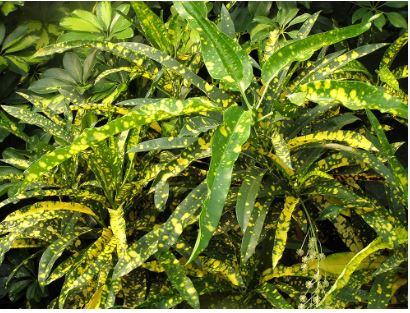
Croton is an extensive plant genus in the spurge family, Euphorbiaceae. The plants of this genus were described and introduced to Europeans by Georg Eberhard Rumphius. The common names for this genus are rushfoil and croton, but the latter also refers to Codiaeum variegatum. These plants are native to the tropical forests of Southeast Asia and the Pacific islands, including regions like Indonesia, Malaysia, and the Pacific islands.
The Eleanor Roosevelt Croton (Codiaeum variegatum ‘Eleanor Roosevelt’) is a variety of the Croton plant named in honor of Eleanor Roosevelt, the First Lady of the United States from 1933 to 1945, known for her extensive public service, advocacy for civil rights, and her role as a diplomat and humanitarian.
The leaves of the Eleanor Roosevelt Croton are long and slender, somewhat resembling the shape of an oak leaf but thinner. The color palette of the leaves includes a base of medium green that shifts to a deep purple, with bright yellow spots scattered across the surface, giving it a unique and colorful appearance. This plant can grow quite tall indoors, potentially reaching up to 3-6 feet, depending on conditions and care. Its growth habit is generally upright, making it a striking addition to any indoor plant collection.
Care Guide
- Light: Like most Crotons, the Eleanor Roosevelt variety thrives in bright, indirect light. Direct sunlight can enhance its colors but should be limited to prevent leaf scorch. Insufficient light can lead to less vibrant leaf colors.
- Watering: Water when the top inch of soil feels dry. It’s crucial to ensure good drainage to prevent root rot. Overwatering is a common issue, so allow the soil to dry out slightly between waterings.
- Humidity: High humidity is preferred. If your home environment is dry, increase humidity around the plant by misting, using a pebble tray with water, or employing a humidifier.
- Temperature: It prefers warm conditions, ideally between 60-85°F (15-29°C). It should be kept away from drafts and sudden temperature changes, which can cause leaf drop.
- Soil: Use a well-draining potting mix. A mix suitable for tropical plants or one amended with perlite or sand for extra drainage works well.
- Fertilization: Feed with a balanced, water-soluble fertilizer every two weeks during the growing season (spring and summer). Reduce or stop fertilization in fall and winter.
- Repotting: Repot every few years or when the plant becomes root-bound. This is typically indicated by roots growing out of the drainage holes or water passing through the pot too quickly.
- Pruning: Prune to shape the plant or remove any unhealthy or overly leggy growth. This can encourage a bushier appearance.
- Propagation: Can be propagated through stem cuttings. Place cuttings in water or directly into soil after treating with rooting hormone for best results.
Why Choose Eleanor Roosevelt Croton?
- Aesthetic Appeal: Its unique leaf shape and vibrant spotting make it a visually appealing plant, perfect for adding a splash of color and tropical feel to any room.
- Air Purification: Like many plants, it contributes to better indoor air quality.
- Statement Plant: Its distinct appearance makes it an excellent choice for those looking to make a statement with their indoor garden.
- Challenge and Reward: While it requires specific care, mastering the needs of the Eleanor Roosevelt Croton can be rewarding for plant enthusiasts looking for a bit of a challenge.